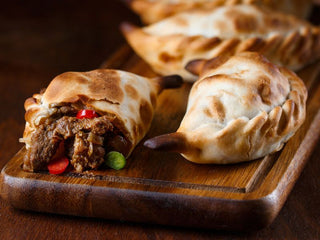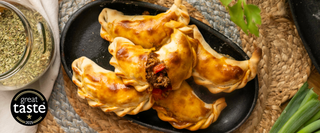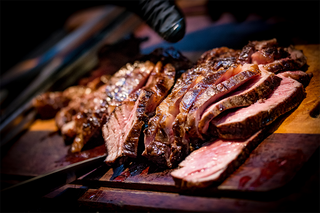Colita de Cuadril
When it comes to Argentine BBQ, few cuts are as underrated, and as delicious, as rump tail, known also as Trip Tip or in Spanish "Colita de cuadril".
Unfortunately, this versatile and flavour-packed cut doesn’t always get the recognition it deserves. But ask for it at a steakhouse in UK, and you might get a knowing nod from the waiter, a subtle sign that you know exactly what you’re asking for.
In this blog, we’ll explore:
-
What rump tail is
-
The best way to cook it on the BBQ (asado style)
-
Pro tips to make it unforgettable
-
Where to buy it in the UK
Let’s fire up the grill. 🔥
What Is Rump Tail?
Colita de Cuadril is a triangular-shaped cut taken from beneath the sirloin, the same region as the iconic Bife de Chorizo. It usually weighs between 675g and 1.2 kg.
It’s a leaner cut, with most of its fat on the outside and little marbling, but when grilled properly, it stays tender and juicy. The outer fat slowly renders over charcoal, infusing the meat with a rich, buttery flavour.
👉 Top Tip: Only buy rump tail that retains its fat cap, it’s essential for flavour and texture.
The Best Way to Cook Rump Tail (Asado Style)
Grilling rump tail the Argentine way requires time, care, and moderate heat. Here’s a traditional asado technique trusted by generations:
Traditional Argentine Grilling Method

Choose a Quality Cut
Only grill rump tail with the fat cap intact. Lightly trim excess fat, but don’t remove the protective layer.
Season Early
Salt both sides liberally with Semi-coarse BBQ salt at least 1 hour before grilling. You can also add chimichurri for extra aroma, however, Max always recommend to season the Colita de Cuadril all over with his secret Beef Rub. Leave it to come to room temperature.
Two-Zone Cooking
Set up your BBQ for two-zone cooking (please follow this link to set up a two zone cooking), the hotter, direct side at a high heat, around 220ºC. Add your choice of smoking wood to the coals, we like to use our low moisture Quebracho Wood, but you can use oak, hickory and beech.
Sear the Colita de Cuadril by placing it on the hotter, direct side of the BBQ for 3-4 minutes per side. Don't be afraid of a little darkness, it's all good flavour.
Adjust the grill height or temperature, or move the beef to the cooler, indirect side of the grill, about 150ºC. Cook for a further 10-15 minutes, turning occasionally, until the internal temperature hits 50ºC for rare or 65ºC for medium-well done. We like to cook it to around 58ºC.
The Most Important Bit, Rest Before Serving: Remove the Colita de Cuadril from the BBQ, cover it properly with butcher paper and leave it to rest for 10 minutes. Just before serving, slice the beef across the grain and serve on a board with the Chimichurri on the side, or in buns with a good spoonful of the chimichurri on top of the meat. You can thanks me later :)

The Secret: Trust the Process
The fat cap isn’t just for show, it’s the secret ingredient. It keeps the meat moist, enhances flavour, and provides that signature buttery finish.
Don’t be fooled by the appearance: after grilling, the sides of the cut may still look slightly pink. Don’t worry, the inside will be perfectly cooked if you followed the timing and resting process.
Internal Temperature Guide
Want precision? Use a meat thermometer for perfect results:
-
Rare: 50°C, Medium-rare: 57°C, Medium-well: 65°C
For asado perfection, aim for medium-rare to medium.
More Pro Tips from the Asador
-
Indirect heat is your friend: After searing, move the meat to a cooler zone of the grill (about 150°C) and cook slowly.
-
Use natural charcoal: For authentic flavour, opt for quebracho or hardwood lump charcoal.
-
Slice against the grain: This ensures every bite is tender.
-
Finish with chimichurri: Just before serving, add a spoonful on top the freshness cuts through the richness beautifully.

Cook Rump Tail in the Oven?
The advantages?
-
Consistent Temperature: Ovens provide steady heat, ideal for even cooking.
-
Juiciness & Tenderness: Slow roasting helps render the fat and keeps the meat succulent.
-
Ease & Convenience: Without the need for outdoor space or constant monitoring, you can achieve that slow-cooked feel indoors.
Step-by-Step Oven Cooking Guide
1. Preparing the Meat
-
Keep the Fat Cap: Ensure the rump tail retains its natural fat cap; this is essential for flavour and moisture as explained above. Lightly trim only any overly thick portions if necessary.
-
Seasoning: Generously rub the meat with Semi-coarse sea salt. For added depth, mix in freshly ground black pepper and a sprinkle of dried herbs (such as oregano or thyme). For an extra kick, you can also rub with a bit of olive oil and crushed garlic.
-
Rest Prior to Cooking: Allow the seasoned meat to rest at room temperature for about 30–60 minutes. This helps the meat absorb the flavours and promotes even cooking.
2. (Optional, but indispensable!) Searing the Meat
For a beautifully caramelised crust:
-
Preheat a heavy-based ovenproof skillet on the stove over medium-high heat.
-
Sear the Rump Tail: Place the meat fat-side down first (about 2–3 minutes), and then sear all other sides until a golden-brown crust forms. This step is optional but adds a depth of flavour.
3. Roasting in the Oven
-
Preheat Your Oven: Set the oven to 160–180°C (320–350°F). Lower temperatures are preferable for a slow roast that melts the fat gradually.
-
Transfer to Oven: If you seared the meat in an ovenproof pan, leave it in. Otherwise, place the rump tail on a roasting tray lined with foil.
-
Cook Time: Roast the meat for approximately 20–25 minutes per 500 grams. For a medium-rare result, aim for an internal temperature of about 57°C. If you prefer medium-well, let it cook until it reaches around 65°C. Using a meat thermometer will help you track the exact temperature.
-
Basting (Optional): Every 15–20 minutes, baste the meat with its own juices or a light glaze (a mix of olive oil, garlic, and herbs works well). This enhances the flavour and prevents drying.
4. Resting the Meat
After removing the rump tail from the oven:
-
Let It Rest: Cover loosely with foil and allow it to rest for at least 10 minutes. Resting redistributes the juices throughout the meat, ensuring every slice is moist and flavourful.
-
Final Touch: As it rests, the slight residual heat continues to even out the doneness, making your roast even more tender.
5. Slicing and Serving
-
Slice Against the Grain: Carefully carve thin slices against the grain. This maximises tenderness.
-
Serve With Classic Sides: Accompany your oven-roasted rump tail with traditional sides such as a fresh salad, roasted vegetables, or a generous drizzle of chimichurri sauce for an authentic Argentine touch.

Pro Tips for an Even Better Roast
-
Internal Temperature Matters: Invest in a digital meat thermometer to ensure perfect doneness.
-
Experiment with Flavour: Try adding a splash of red wine or balsamic vinegar to your basting mixture for a slightly tangy contrast.
-
Pairing: Serve with a robust red wine such as Malbec to elevate your dining experience.
Why Colita de Cuadril Deserves More Love
It may not be as famous as Ribeye A.K.A. Ojo de Bife or Beef Spare Ribs A.K.A. Tira de Asado, but rump tail is a hidden gem of the Argentine BBQ world.
Easy to cook, rich in flavour, and elegant on the plate, once you try it, it’ll become a regular guest at your grill.
Ready to Elevate Your Roast?
At Casa Argentina, we pride ourselves on offering premium-quality rump tail and other succulent Argentine cuts. Perfect for your next oven roast or BBQ, our meats come with next-day UK delivery and a satisfaction guarantee.
👉 Shop Premium Rump Tail
👉 Explore Our Argentine Meat Collection

 0208 540 1222
0208 540 1222


